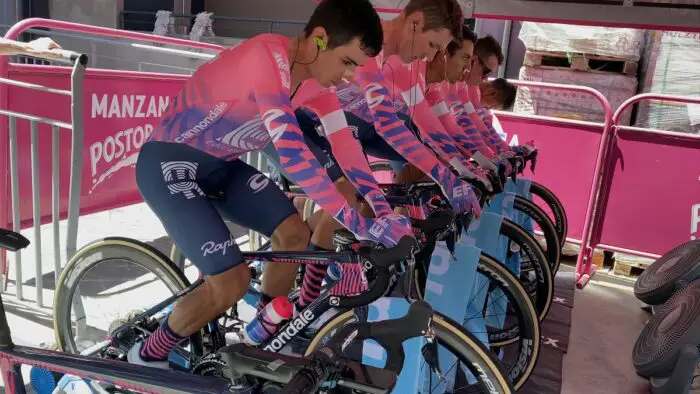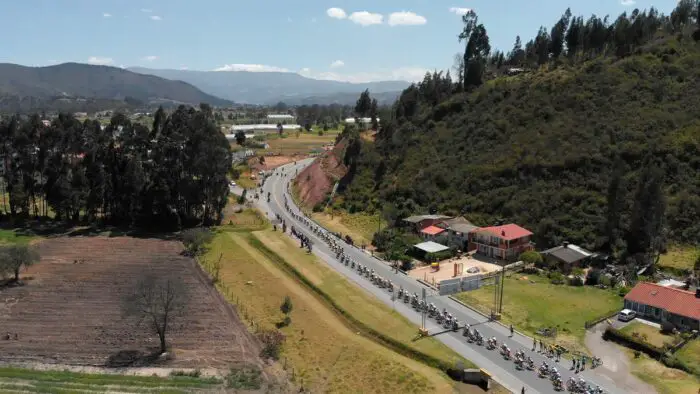Avid cyclists and casual fans of the sport like myself look forward to the Tour de France every year. Few events can match it for its grueling hills, complex tactics, extraordinary scenery, rabid fandom, and epic feats of glory—or, at times, harsh, crashing agony. This year marking its 120th anniversary, it’s without doubt one of the world’s most fêted events, the most prestigious in its sport and recognized as the world’s biggest annual sporting event. What’s it take to win—or even compete? Up close and personal, the new documentary Enter the Slipstream, available now on streaming, embeds a filmmaker within the Education First (EF) Cycling Team as they navigate a turbulent, COVID-impacted 2020 season, getting a first-hand look at the guts, grime, brains, and blood of the Tour de France.
The 23-day, 21-stage race, contested by 22 teams from across the world, each with up to nine riders, takes its 200-some riders over 2,000 miles across France (and sometimes beyond: this year’s Tour, for instance, kicks off in Bilbao July 1) at average speeds of 25 mph and up to 70 mph. The teams are usually comprised of a lead rider and the domestiques who work to support him, in addition to an owner-manager and the support staff of mechanics and physios.
Education First, recognizable for their bright pink kits and Cannondale bikes, is now the oldest professional cycling team in the U.S., first as a junior development squad and then, in the wake of the Lance Armstrong scandal, as a professional team dedicated to repudiating the sport’s doping culture. Over the course of the last decade, Jonathan “JV” Vaughters, a former pro and teammate of Armstrong’s, has built a squad committed to competing at the highest level and drug free.
The year 2020 began with great promise for the team as they swept the top three spots at the season’s major race, Tour Colombia, and it was with great optimism that EF descended on France, with their top rider, Rigoberto “Rigo” Urán, the Colombian superstar, returning to form after a catastrophic injury.

In addition to their star rider, EF’s supporting cast is strong with Rigo’s two acolyte-countrymen, Dani Martinez and Sergio Higuita, fellow riders who would both would sacrifice themselves to place Rigo on the podium. Two U.S. riders play key roles: the cagey veteran TeJay van Garderen, a nine-year Tour de France vet with two young daughters across the Atlantic, and the up-and-coming superstar Neilson Powless, the first Native American to compete in the Tour, just signed to EF after a strong rookie season for Jumbo-Visma.
Enter the Slipstream accompanies Vaughters and the EF team from Colombia to Spain and then France, where the Tour takes them from the Cote-d’Azur through 3,000 kilometers of French countryside all the way to the Arc de Triomphe. While the riders, collectively and individually, face their own victories and heartbreaks, from on-course failures to strong finishes, from crises of confidence to heinous acts of unsportsmanlike conduct, Vaughters has another pressing matter: the team’s finances, in danger of collapsing at the most complicated of moments. The mission he’s worked ceaselessly to support for more than a decade now seems so precarious it’s impacting his health.

And then, of course, there is COVID, shutting down the streets of Paris and every major city in the spring of 2020, threatening even to cancel the race the cyclists have trained for. Fortunately, with some considerable trepidation and precaution, the race goes on, the riders facing down their fears and Vaughters keeping a brave face in front of financial distress.
For as complex an undertaking as the Tour itself may be, imagine for a second the work needed to capture it. Skilled camera operators need to know every nook and cranny of the race’s 2000-mile route and have the gear and access to capture every single moment: one never knows when or where, exactly, the precise moment the race is won or lost might occur. Then there are the restrictions of COVID: in the case of Enter the Slipstream, the documentary team was told point-blank they would not have access to the event, even after six months of intensive planning.
Given that directive, it’s a wonder the documentary exists at all.
Director Ted Youngs refused to yield the project either to COVID or the Tour’s organizers, embedding a camera operator inside the team as they traveled, using a second team to document the race and its fanfare from the ground more broadly. Embedded with the team, cinematographer Samantha André captures the human emotion and intimate moments in the team and owner’s lives with her revealing interviews and candid conversations. The overall presentation may seem a bit, shall we say, pedestrian in its approach—not quite able to capture the intensity of the racers’ daring and a bit overdependent on talk-to, lower-thirds, static-camera interviews—but there’s no shortage of surprising revelations and keen insights.
More, though, than a simple sports documentary tracing the travails and triumphs of those who compete, Enter the Slipstream examines the fragility of such endeavors: the economics of a multinational sport vulnerable to a sudden coronavirus outbreak, the moments that ignite or conclude a long and joyous career, the unsolvable tensions between the solitude of cycling and the teamwork the Tour demands. Come July, when another 22 teams and 2,000 riders descend on Bilbao for the start of the 2023 Tour, EF will be back in the hunt, once again, for its first Tour trophy, and millions will be watching. Until then, Enter the Slipstream makes for an excellent behind-the-scenes look at all the thousands of moving parts it takes for a team to tackle sport’s most enduring, grueling competition.
The Tour de France cycling documentary Enter The Slipstream, directed by Ted Youngs and produced by Versus, is available from Monument Releasing on all major digital platforms including Apple, Amazon, inDemand and Vimeo. Run Time: 88 min.




